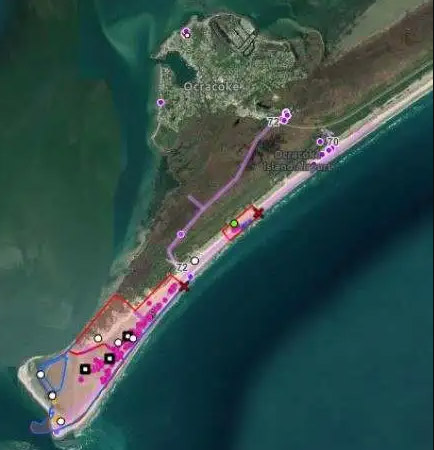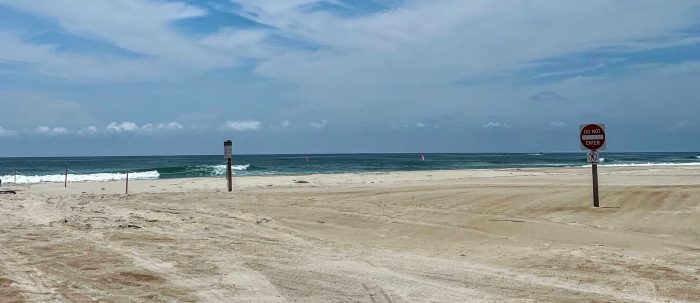
A recent increase in nesting Least Terns on Ocracoke’s South Point prompted National Park Service staff to close that section of the beach from near to the entrance at Ramp 72 to the end of the island.
The closure, in effect July 3, begins just .11 miles south of the ramp entrance, said Meaghan Johnson, chief of resource management and science, for the Cape Hatteras National Seashore.
“You can’t turn right and it’s the July 4 holiday,” one islander said about the closed off area, adding he’d never seen it closed off so close to the ramp before.
But Mike Barber, public affairs officer for the Seashore, said this year’s closure at South Point was about consistent with last year’s.
Last year, the closure began a little farther south, or .43 miles south of the ramp, he said.
Johnson said the closure should continue into August.
That’s because there’s a 20-day incubation period before the chicks hatch, she said, and then about another 20 or more days before they fledge.
“Through August this area is active with nesting and chicks,” she said. “It’s the highest density of colonial waterbirds on Ocracoke.”
As of now, there are 147 active colonial waterbird nests, she said, including 86 Least Tern nests, 20 Black Skimmer nests, American Oyster Catchers and a few Gull Bill Tern nests.
Least Terns are the primary colonial nesting birds at South Point and is a species of concern for the state, Johnson said.
Last year the beach nesting birds at South Point had a massive failure due to a combination of heavy rain, overwash, high winds and mammalian predation.
“This is the furthest north they’ve nested,” Barber said about this year, but the island has several other open beach access areas.
“Overall, along the entire island, there’s more than 7.22 miles of Off-Road Vehicle areas open,” he said. “There’s over five miles open for pedestrians. So added together, there’s more than 13 miles of beach open.”
The Park Service protects all nesting wildlife, Johnson said.
When the staff finds a Least Tern nest, they place a 100-meter buffer around the colony as wells as any chicks they find, Johnson said. Some Least Tern nests were found close to the beach entrance at Ramp 72, prompting the closure.
The buffer for Black Skimmer nests is 180 meters.
“With all of this nesting activity there’s no way to allow beach access,” Barber said. He added that Cape Point at Cape Hatteras also is closed to vehicles and pedestrians.
Barber said beach access and nesting bird information is updated weekly on the following pages on the Cape Hatteras National Seashore webpage:
Beach Access Table & Mileage Summary: http://go.nps.gov/beachaccess. The mileage summary is updated every Thursday during the nesting season.
Field summary: http://go.nps.gov/fieldsummary. The field summary is updated every Thursday during the nesting season.



